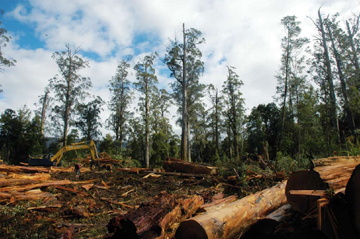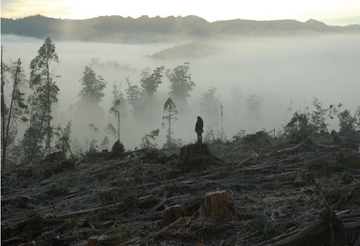A new report released by Australian conservation groups The Wilderness Society and Still Wild, Still Threatened shows that despite claims to the contrary, Japanese paper manufacturers are the purchasers of wood chips derived from the destruction of Tasmania’s old growth forests.
This revelation comes after a major scandal in Japan where it was revealed that Nippon and Oji were misleading consumers about the amount of recycled paper content in their products. That scandal caused major embarrassment for the companies and led to the resignation of Nippon Paper’s president, Masatomo Nakamura. In January 2008 Shoichiro Suzuki, chairman of the Japan Paper Association and Oji Paper admitted they had been falsifying the amount of recycled content in their paper products.
 Logging coupe SX010F, 10th December 2007 / Photo: Laura Minnebo |
Now a new crisis looms as it appears extremely likely that Nippon and Oji are the recipients of at least 268,000 green tons of woodchips from Tasmanian old growth and mature forests each year. The report ‘Oldgrowth for Export’ highlights how those companies, the two major customers of Tasmanian woodchipping giant Gunns, are receiving old growth woodchips.
Old growth forests in Tasmania are being destroyed by logging and burning. Over 85% of the logs extracted from those forests end up as woodchips for export, largely to Japan where they processed into paper. Nippon and Oji are have been shown to have misled people about the use of recycled content in their paper, reportedly in an attempt to try and lure green-minded customers.
“We know that environmentally-conscious consumers in Japan will not want to source paper products that are made from the destruction of irreplaceable forests in Tasmania,” said Paul Oosting, pulp mill campaign manager for The Wilderness Society (Tasmania).
‘Old growth for Export’ presents a case study of old growth logging in the Derwent forests of Tasmania. It draws together information from a range of sources, including Forestry Tasmania, the Regional Forest Agreement, the Forest Practices Authority and the Australian Bureau of Agricultural and Resource Economics, in order to paint a picture of where the logs from Tasmania’s old growth forests go. The report refutes claims circulating in international pulp-industry circles that woodchips from Tasmanian do not contain old growth wood.
The main findings of the report ‘Oldgrowth for Export’ are:
- Approximately 78% of the original extent of tall-eucalypt forests have already been cleared or are available for logging;
- 61 000 hectares of tall-eucalypt RFA old growth are currently unprotected from logging;
- The dominant product from logging of Tasmania’s public native forests is pulpwood (86%), with less than 5% becoming solid wood products;
- The vast majority of pulpwood from Tasmanian native forests – and an even higher proportion of pulpwood sourced from publicly-owned RFA old growth forests – are exported by Gunns Ltd as woodchips;
- A significant proportion (at the absolute lowest, 20%) of woodchips from mature and old growth forests are exported to Japan.
 Logging coupe WE034D, 25th June 2007 / Photo: Laura Minnebo |
“This report presents irrefutable evidence to show significant tracts of tall-eucalypt old growth and other high-conservation-value forests in Tasmania are being woodchipped and exported to Japan by Gunns Ltd,” said Oosting. “Whilst the Japanese paper companies were misleading people about using recycled paper in their products they were actually buying large amounts of old growth woodchips from Tasmania.
“We hope that this exposure and a backlash from Japanese consumers will help convince Nippon and Oji to cease buying woodchips from old growth and high-conservation-value forests in Tasmania and take a more environmentally responsible path into the future.“
The the full report is available at http://www.wilderness.org.au/articles/old-growth-for-export-article